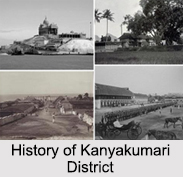 History of Kanyakumari District dates back to the year 1956 when it was formed by the passing of the States Re-organisation Act. Kanyakumari is the smallest and the southernmost district of Tamil Nadu. The district is also considered as the southernmost tip of Indian Peninsula. Until the decline of the Pandya dynasty, Kanyakumari was under the rule of the Paravar Kings and later on was under the authority of kings of Travancore indirectly as they had to accept the British supremacy.
History of Kanyakumari District dates back to the year 1956 when it was formed by the passing of the States Re-organisation Act. Kanyakumari is the smallest and the southernmost district of Tamil Nadu. The district is also considered as the southernmost tip of Indian Peninsula. Until the decline of the Pandya dynasty, Kanyakumari was under the rule of the Paravar Kings and later on was under the authority of kings of Travancore indirectly as they had to accept the British supremacy.
Origin of Kanyakumari District
To trace the origin of Kanyakumari one has to go back to its early history. The first available evidence about Kanyakumari is found in Taittiriya Upanishad which belongs to the 6th century B.C. It mentions about the existence of Cape Comorin which was once a part of the Chera kingdom.
Legends related to Kanyakumari District
Several mythological stories have been told regarding this place. One such story is that of Goddess Parvati"s incarnation, Kanya Devi. She was to marry Lord Shiva but he never turned up on the wedding day. The grains to be cooked for the wedding remained uncooked and idle afterwards. As time passed by the grains were turned to stones. Kanya Devi, thus, is considered a virgin Goddess and blesses pilgrims and tourists who visit the town.
Another story is related to Lord Hanuman. According to this legend, while carrying the Sanjivani plant, Lord Hanuman dropped a piece of the plant on the earth. This is why there are number of medicinal plants in the area and it is called "Marunthuvazh Malai".
Another Hindu legend relates the story of Sage Agastya. It is assumed that he lived around this area. As he was proficient in therapeutic herbs, some believe that this could be the reason for so many medicinal herbs to be found on these hills near Kanyakumari.
Different Rulers of Kanyakumari District
The Travancore region was in anarchy before Marthanda Verma ascended the throne in 1729 AD. Before his reign, the Samanthan Nairs ruled the province. Under their rule anarchy was dominant in Kanyakumari region. However, Marthanda Verma brought a sense of disorder under control by annexing the nearby territories. He had also bought some portions of Kanyakumari from the then viceroy making it the southern boundary. Under his rule the district improved in a social context as well as economically. In the year 1949, the area became a part of the re-established Travancore-Cochin state. However, under the rule of Marshal A. Nesamony, an extreme agitation by Tamil speaking residents took place for including Kanyakumari within Tamil Nadu. Eventually the merger happened in 1956 based on language reorganization of states.
Caste Divisions in Kanyakumari District
The society in Kanyakumari District had many several caste based divisions. Hindus, Christians, Muslims, Jains, Buddhists and Jews were the major castes. The Hindus were further divided into sub-castes. The most important community was the Nair community. The lower castes mainly comprised the Nadars and the Ezhavas. They suffered oppression in the hands of upper caste. Since the Nadars belonged to the low caste group, they were not allowed to go near a Brahmin or Nair. They were prohibited from doing many activities. Many economic and social restrictions were imposed on them. The beginning of 19th century witnessed a revolution.
Emergence of Christianity in Kanyakumari District
The then British residents can be held responsible for the introduction of Christianity in Travancore. Many missionaries had expanded their humanitarian reach which protected the lower castes from high caste oppression. Thereafter revolts of Nadar community followed in districts like Kalakulam, Vilavancode, Deviculam, Nanjil Nadu and Neyyoor Region which are now in Kanyakumari district.



















